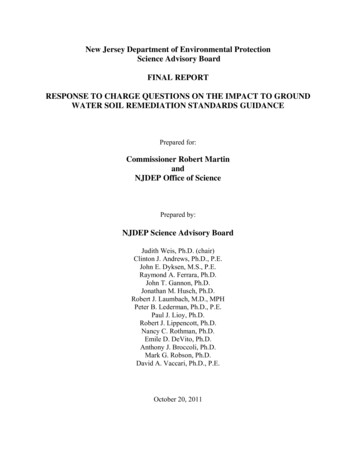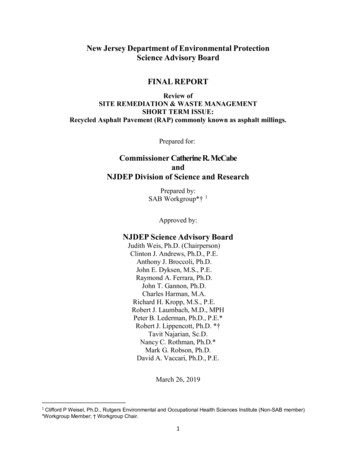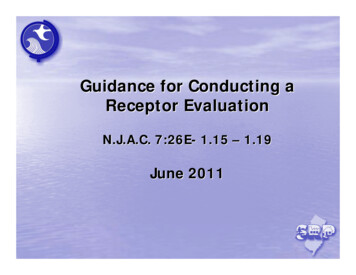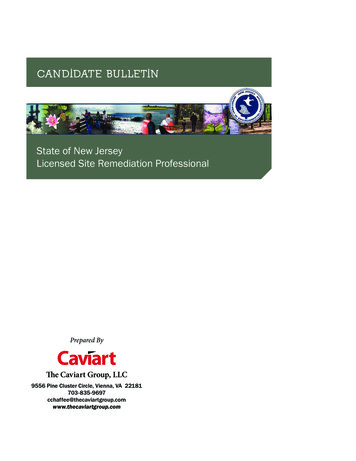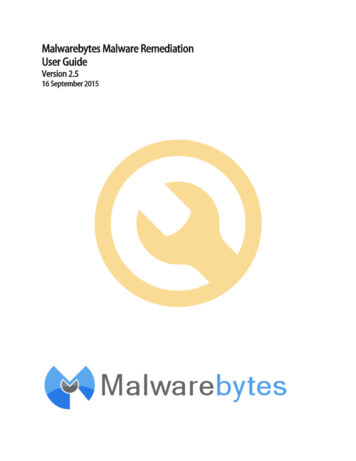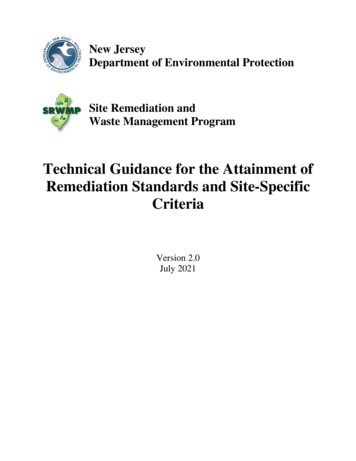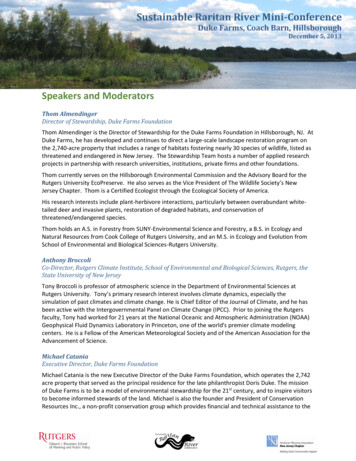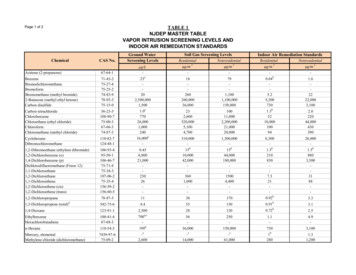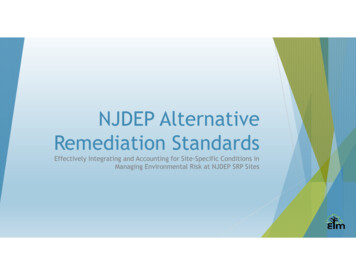
Transcription
NJDEP AlternativeRemediation StandardsEffectively Integrating and Accounting for Site-Specific Conditions inManaging Environmental Risk at NJDEP SRP Sites
Overview - Alternative Remediation Standards Alternative Remediation Standards (ARSs) – Direct Contact Pathway Ingestion-Dermal Lead Contaminated Sites Recreational Land UseInhalation VOCs – depth & organic content Particulates Recreational Land UseARSs - Impact to Groundwater Pathway Soil-Water Partition Equation Immobile Chemicals Dilution Attenuation Factor Sesoil / ATD123 SPLP Soil and GW Evaluation - VOCs, Metals, SVOCs Capping to Satisfy Impact to Groundwater Pathway Vapor Intrusion - Alternative Screening Levels for Groundwater2
Things to KIM when Selecting Standards Standards vs. Criteria vs. Screening Levels Present and Future Land Use Receptors & Exposure pathways – ARSs are Pathway Specific Background, Offsite, and Diffuse Anthropogenic Pollution ARS development should follow the CSM Cost-benefit of developing ARSs vs default standards remediation Forms and other documentation required by NJDEP for ARSs3
NJDEP Standards, Criteria,& Screening Values NJAC 7:26D – Remediation Standards Direct Contact Soil Remediation Standards Impact to Groundwater (IGW) Soil Standards (Default or Site-Specific) Groundwater Quality Standards (GWQS) (NJAC 7:9C) Surface Water Quality Standards (SWQS) (NJAC 7:9B) EE TG – Ecological Screening Criteria – Sediment/Surface Water Protocol for Addressing EPH Guidance NJDEP Chromium Soil Cleanup Criteria (2010) – Soil, Groundwater VI TG Screening Levels - Groundwater, Soil Gas, Indoor Air Vanadium - USEPA Regional Soil Screening Level of 390 mg/kg LNAPL Guidance / Sheen Policy4
NJDEP Soil Remediation StandardsNJDEP Soil Remediation Standards (SRSs) – NJAC 7:26D Residential (Res) and Non-Residential (NR) Direct Contact (DC) SRS Ingestion-Dermal Criteria (Equations and Assumptions - Appendix 2) Inhalation Criteria (Equations and Assumptions – Appendix 3) Practical Quantification Limit (PQL) DC SRS is more stringent of ingest.-dermal or inhalation criterion, assuming nonlimiting PQL Table 1A - Res DC criteria, PQLs, and SRSs; Table 1 B - NR DC criteria, PQLs, andSRSs Impact to Groundwater (IGW) SRS developed on a site-specific basis per NJAC7:26D-1.1(b) Develop IGW ARS using one of NJDEP methods; or Default IGW Soil Screening Levels (IGWSSLs) - Table 1 of Soil-Water Partition Equation5(SWPE) Guidance
Regulatory Basis for Developing of Soil ARSsNJAC 7:26D-7.3, basis for the development/request of alternativeremediation standard may include:1.New chemical toxicity data;2.New risk assessment models or methods;3.Alternate land use planned for Site;4.Site specific conditions supporting modification of input parameters for SRSs5.Conditions which require cleanup to a level more stringent than SRSDevelopment of ARSs Ingestion-Dermal DC – NJAC 7:26D, Appendix 4 Inhalation DC – NJAC 7:26D, Appendix 5 Impact to Groundwater – various NJDEP IGW Guidance DocumentsARSs are exposure pathway specific. Need to determine which COCs and pathways arerisk/cost drivers and strategically evaluate ARS options. Make sure that any ARS youdevelop is protective for all pathways/receptors (i.e., HH ingestion-dermal, HH6inhalation, IGW, and ecological).
Direct Contact Soil ARSs – Ingestion-DermalLead Contaminated Sites Requires NJDEP Pre-Approval Res ARSs may be developed using Integrated Exposure Uptake Biokinetic Modelfor Lead in Children (IEUBK - EPA, 1994) and site data for lead in soil & dust. NR ARSs may be developed using input parameters in Recommendations of theTechnical Review Workgroup for Lead for an Interim Approach to AssessingRisk Associated with Adult Exposures to Lead in Soil (USEPA, 1996). ARSs for lead may be developed for recreational land use using non-continuousexposure (all ages) identified in Assessing Intermittent or Variable Exposuresat Lead Sites (USEPA, 2003)7
Direct Contact Soil ARSs – Ingestion-DermalRecreational Land Use Requires NJDEP Pre-Approval ARS based on site-specific land use scenarios effecting how and how longpeople use a recreational site. Two types of recreational land use:Active - sports playing fields and playgroundsPassive - walking or bike trails. Approval of an ARS for recreational land is contingent on the use of properinstitutional controls (ICs) to ensure the future use of the site for theproposed recreational purpose.8
Direct Contact Soil ARSs – InhalationVOCs – Adjusting Depth Range of Contamination Theory: Finite COC depth (bottom) reduces Volatilization Factor (VF) Model Default – Infinite Depth of COCs Does not Require NJDEP Pre-Approval IC not required when depth range of COCs begins at surface, but isrequired when depth range of COCs begins below the ground surface.Method for Developing1.Determine depth range of contamination via sampling & analysis perN.J.A.C. 7:26E-4.2.Use observed depth range of contamination in the Jury Model(EMSOFT Package) to derive a site-specific VF3.Substitute calculated VF into Equations 1 or 2 N.J.A.C. 7:26D,Appendix 2, to calculate an inhalation ARS.9
Direct Contact Soil ARSs – InhalationVOCs – Adjusting the Organic Carbon Content of Soil Theory: Increased organic carbon fraction reduces volatilization flux. Does not require Department Pre-Approval IC is not required when adjusting the Organic Carbon Content (OCC)Method for Developing1.Collect 3 samples (min) from different locations in each AOC. Can’t be collected fromareas with total VOCs 1,000 ppm.2.Analyze samples for soil OCC using the Lloyd Kahn Method.3.Use the average soil OCC as the foc in the App. 2, Eq. 5 to calculate Kd.4.Substitute Kd into App. 2, Eq. 4 to calculate Apparent Diffusivity (DA).5.Substitute DA into App. 2, Eq. 3 to calculate a site-specific VF.6.Substitute the site-specific VF into App. 3, Eqs 1 or 2 to calculate inhalation ARS.10
Direct Contact Soil ARSs – InhalationParticulates – Adjusting Fraction of Vegetative Cover Theory: Increase in vegetative cover decreases emission of particulates Residential Sites Only Does not require NJDEP Pre-Approval IC required for ARS based on vegetative cover condition of SiteMethod for Developing1.Measure amount of vegetative cover fraction (V) on the site. Acceptablevegetative cover are areas of continuous grass with no exposed ground.2.Substitute the measured V into Equation 11, Appendix 2 to calculate theparticulate emission factor (PEF).3.Substitute the PEF into Equation 9 or 10 of Appendix 2 to calculate theparticulate contaminant carcinogenic or noncarcinogenic inhalation ARS.11
DC Soil ARSs – Inhalation - ParticulatesParticulates – Adjusting Truck Trips Per Day Theory: Less Traffic Stirs Up Less Dust Non-Residential Sites Only Does not require NJDEP Pre-Approval IC required based on number of vehicles used in calculation.Method for Developing1.Determine daily traffic count (TC) for an unpaved area by dividing the weekly totalnumber of vehicles by the number of days of site operation that week.2.Substitute TC into Eq. 20, App. 2 to calculate the particulate emission rate for sitetraffic (ER-traffic).3.Substitute ERtraffic into Eq. 19, App.2 to calculate the particulate emission factor(PEF).4.Substitute PEF in Eq. 18, App. 2 to calculate the exposure dose calculation (DOSE).5.Substitute DOSE into Eq. 14 or 15, App. 2 to calculate the COC carcinogenic ornoncarcinogenic inhalation ARS.12
Direct Contact Soil ARSs – InhalationRecreational Land Use Requires NJDEP Pre-Approval ARS based on site-specific land use scenarios effecting how and how longpeople use a recreational site. Two types of recreational land use:Active - sports playing fields and playgroundsPassive - walking or bike trails. Approval of an ARS for recreational land is contingent on the use of properinstitutional controls (ICs) to ensure the future use of the site for theproposed recreational purpose.13
Impact to Groundwater ARS Per NJAC 7:26D-1.1(b), Must develop IGW-ARS (or utilize Default IGWSSLs). Generally, IGW ARS should be evaluated/developed if COC IGWSSL, unless : cost of remediation to IGWSSL is less than cost to develop IGW ARS; or DC standard (default or ARS) or other relevant cleanup standard is more stringentthan default IGWSSL. IGWSSLs calculated using SWPE; derived via back calculation using GWQSs andNJDEP standard assumptions. Guidance for developing IGW ARS currently provided in numerous, separatedocuments; NJDEP currently combining into one comprehensive document.Dilution Attenuation FactorSoil Water Partition EquationSynthetic Precipitation & Leaching ProcedureImmobile ChemicalsSite Soil and GW Data EvaluationSesoil & Sesoil/ATD12314
Impact to GW ARSs – Soil-Water Partition Eq.Theory/Application: COCs exist in three phases in the environment. SWPE calculates amount of COC that canremain in unsaturated soil such that corresponding GW COC conc health-based GWQC.Use Recommended:oSite-specific DAF default valueoOrganic contaminants, site-specific soil organic content (foc) default valueRequired : SPLP is used to calculate a site-specific soil-water partition coefficient (Kd)oNot Applicable for AOCs where total VOC contamination exceeds 1,000 mg/kg.Calculation/Methods: Modified EPA Soil Screen Level S/W Partition Equation (EPA 1996). Three calculationspreadsheets dependent on input variable modified: DAF, foc, or Kd.Guidance – Development of Impact to Groundwater Soil Remediation Standards using the Soil-Water PartitionEquation (Version 2.0; November 2013)Assumptions: Default site conditions/assumptions for calculation of IGWSSLs - refer to Section VI of Guidance.Chemical property inputs ies.pdf);Reporting: Spreadsheet at www.nj.gov/dep/srp/guidance/rs/partition equation.xls Submit copy of completed15spreadsheets and all input parameters values utilized to determine site-specific IGW ARS to NJDEP.
Impact to GW ARSs – Soil-Water Partition Eq.Four input variables may be modified in SWPE: Fraction Organic Carbon (foc) Collect minimum of 3 representative soil samples, analyze samples for organic carbon using Lloyd Kahnmethod Substitute average organic carbon as foc in Eq. 1a; if organic carbon varies order of magnitude, uselowest valueSoil-Water Partition Coefficient (Kd) Collect and analyze samples per the SPLP Guidance Use SPLP Spreadsheet to derive a site-specific Kd Substitute site-specific Kd into Eq. 1bEq.1AEq.1BDilution-Attenuation Factor (DAF) Develop a site-specific DAF per the DAF Guidance Substitute site-specific DAF into Eq. 1a (organics) or 1b (inorganics, or site specific Kd)Ionizable Phenols - Koc for Soil pH Collect minimum of 3 representative soil samples, measure soil pH in each sample Use soil pH for each sample to determine corresponding Kocs from Table 2 Use Kocs to calculate IGW ARSs using Eq. 1a, average if ARSs vary by less than OOM16
Impact to GW ARSs – DAF GuidanceTheory/Application: Infiltration containing leached COCs recharges an aquifer. Theamount of dilution and resulting ground water COC concentration is calculated viathe dilution-attenuation factor (DAF).Calculation/Methods: Calculate site-specific DAF and substitute into the Soil-WaterPartition Equation when calculating an IGW ARS.Guidance: Development of a Dilution-Attenuation Factor for the Impact toGroundwater Pathway (Version 2.0; November 2013)Assumptions: NJDEP standard inputs for calculation of default DAF (20) is includedin Appendix A of guidance;Reporting: Spreadsheet at http://www.nj.gov/dep/srp/guidance/rs/daf calc.xls;Submit completed spreadsheet and all input parameters values to NJDEP.17
Impact to GW ARSs – DAF GuidanceFour input variables may be modified in DAF Equation:1.2.3.4.Length of AOC, parallel to GW flow (L): only effective when length is large enough to cause mixing zone depth thickness of aquifer site-specific L must be utilized when calculating a site-specific DAF Default NJDEP input for L 100 feetInfiltration Rate (I): Consultation with NJDEP required for use of site-specific infiltration rate Default NJDEP input for I 11 inches/yearHydraulic Conductivity (K) and Gradient (i): Determine K and L per NJDEP GW Technical Guidance DAF has linear relationship to both K and I Default NJDEP inputs – K 142 ft/day; I 0.003Aquifer Thickness (da): Thickness to be measured in field or determined using NJGS or USGS data Default NJDEP input for da 3.5 meters (11.5 feet)18
Impact to GW ARSs – SPLPTheory/Application – Simulates leaching of COC via infiltration using an extraction fluid.COC concentration in leachate is compared to COC-specific leachate criteria (DAF x GWQC).Use Recommended:Most beneficial for developing IGW ARSs for inorganics & low mobility organics (Koc 20,000 L/kg). Consider collecting additional sample for SPLP to obviate remobilizations.Calculation/Methods - SW-846 Method 1312 – Analysis of both leachate (mg/L) and totalCOC concentration in sample. SPLP utilized to derive: (1) Site Kd for use in SWPE; and (2)Site IGW ARSs . Evaluation of results using one of three methods.Guidance – Development of Site-Specific Impact to Ground Water Soil RemediationStandards using the Synthetic Precipitation Leaching Procedure (Version 3.0; November2013)Assumptions: Default Leachate Criteria for Class II Groundwater Class II Groundwater(Appendix B)Reporting: Spreadsheet at http://www.nj.gov/dep/srp/guidance/rs/splp spreadsheet.xls.Numerous additional parameters required for reporting for each sample for SPLP.19
Impact to GW ARSs – SPLPSPLP Methodology:1.Collect minimum of 3 samples from each AOC. Collect samples representing therange of COC detections (up to and including highest detection). Approximately120 grams (4-5 oz) of sample is needed for SVOC and Metals SPLP analysis.2.For VOCs do not homogenize sample, but collect separate, yet like samples for inencores. Make sure to collect additional sample for moisture and pH.3.Submit samples for analysis of total COCs and SPLP COCs, pH, and moisture (allincluded in SPLP package for most labs).4.Determine Site Leachate Criteria (LC): (1) Default, health-based LC (GWQC x 20);of (2) Site-Specific LC based on Site-specific DAF (GWQC x ss-DAF). LC cannotbe greater than water solubility of COC.5.Calculate Field Leachate Criteria (FLCs) for each sample using the NJDEP SPLPcalculator. Spreadsheet also calculates site-specific Kd values which can besubstituted into the SWPE for developing IGW SRSs.6.Compare FLCs to LCs to determine IGW ARSs via any or all of three evaluationoptions. NJDEP Spreadsheet performs evaluation via all three options.20
Impact to GW ARSs – SPLP1.Tabular Evaluation Tabulate total COC concentrations in ascending order with respectivefield leachate concentrations (FLCs). Compare sorted FLCs versus LC: If all FLCs LC, IGW is the highest total COC concentration Otherwise ARS is the highest total COC concentration whose corresponding FLC LC21
Impact to GW ARSs – SPLP2.Calculate Site-Specific Kd and substitute into SWPE Use total COC concentration and respective FLC to calculate samplespecific Kds using Eq. 1. Average sample-specific Kds if vary by less than an order of magnitude, Ifthey vary by more than order of magnitude, use lowest sample-specific Kd Substitute the calaculated Kd into Eq. 3 to calculate IGW ARSEq. 1Eq. 322
Impact to GW ARSs – SPLP3.Linear Regression1.Plot total COC concentrations on x-axis2.Plot respective FLCs on y-axis3.Determine if data passes linear correlation test (r2 0.7):4.Calculate IGW ARS using Equation 4Eq. 423
Impact to GW ARSs – Immobile ChemicalsTheory/Application : “Immobile chemicals” become resistant to desorption from soilwith increased contact. Over time these chemicals can become irreversibly adsorbed tounsaturated soil and do not pose a threat to GW if adequate “clean zone” of soil existsabove the water table. Typically immobile chemical conditions should be evaluated afterthe RI is complete, but RI should include strategic sampling that will help support adetermination if conditions are a)PB(b)FB(g,h,i)PB(k)FBEHPButyl Benzyl PthDi-n-Butyl Pth ptachlorHept EpoxideHexClBenzeneHC-1,3-butadieneHC-C enePCBsReporting: Submit the following to demonstrate Immobile conditions: Soil Boring Logs All soil analytical results (including those in two foot clean zone) Table Comparing analytical results with the Site-Specific Impact to GW Soil RemediationCriteria; and Discussion and support documentation (as needed) relative to site/soil conditions in guidance.24
Impact to GW ARSs – Immobile ChemicalsGuidance: Evaluation of Immobile Chemicals for the Impact to GroundwaterPathway (June 2008)Methods: Demonstration of Immobile Conditions:1.Immobile Chemical is listed in NJDEP Guidance; and2.Clean ( IGWSSL) zone exists between contamination and water table; and3.None of the following site conditions exist: COC was discharged as mixture that could affect mobility of COC; Co-solvent is present that could affect mobility of COC; Soil (or fill material) texture at the site is more course than sandy loam; Soil pH has been altered by release of acids or bases (caustics); or The COC is present at levels indicative of free or residual product.25
Impact to Groundwater ARSs –SESOIL / AT123D ModelingSESOIL ModelSESOIL/AT123D Model Groundwater is not impacted Groundwater is already impacted Clean or “buffer” zone existsbetween impacted soil andgroundwater Both soil and groundwaterimpacted Used to demonstrate thatcontaminant concentrations willnot lead to unacceptablegroundwater impacts (extent orduration of current impacts) Used to demonstrateconcentrations in soil will notlead to groundwaterconcentrations above theGWQS26
Impact to Groundwater ARSs – SESOILMethod – Contaminant transport in the vadose zone SESOIL model evaluates soil concentration distribution to generate depth-dependentIGW ARSs distribution, rather than a single number.1.Confirm site conditions do not adversely impact GW; or2.Develop site specific criterion for response action. If either 1 or 2, then no further action required for IGW pathway (no monitoring, noengineering/institutional controls)Application Contaminant has low mobility not eligible for “immobile contaminant” option failed SPLP test Contaminant has high mobility limited in distribution and/or present at low concentrations27
Impact to Groundwater ARSs – SESOIL/AT123DMethod – Contaminant transport in vadose zone & via groundwater Estimate the time required for attenuation of contaminant concentration via transport toand through contaminated aquifer. GOAL is to demonstrate the soil and gw impacts willnot:1.enlarge the current groundwater plume, or2.extend the estimated time period.Model predicts COC concentration at two compliance points – predicted over 10’ intervalApplication AOC cannot have impervious cap - leverages infiltration/recharge and volatilization rates Highly contaminated soil (e.g., NAPL) remediated in accordance with applicable regs Soil and GW impacts have been delineated – horizontally & vertically Overburden, unconfined aquifer – not able to model flow through bedrock Must complete/conduct receptor evaluation28
Impact to Groundwater ARSs – SESOIL/AT123DData COC concentrations in soil and groundwater must be delineated Soil concentration distribution (highest concentration used for sublayers not sampled) GW plume extent and estimated time period (CEA parameters) Default values in model for weather parameters and chemical properties of COC Site-specific, measured Kd value can be used (from soil with highest COC concentration) For ionizable organics, measure soil pH (min of 3) to select appropriate Koc value REQUIRED site-specific soil data For each distinct soil layer (including aquifer, if using AT123D), average from a minimum of 3 samples Soil texture using particle size distribution, including silt and clay fractions (e.g., sieve analysis with hydrometeranalysis of fines) Soil organic carbon – recommended Lloyd Khan method Aquifer parameters, use MNA guidance to determine site-specific: Hydraulic conductivity Hydraulic gradient Effective porosity (use default in model guidance or site-specific) Bulk density (use default in model guidance or site-specific)29
Impact to Groundwater ARSs – SESOIL/AT123DReporting Short writeup, describe/present all input parameters, and provide copies of graphicaloutputs from the modelGuidance SESOIL (Dec. 2008): http://www.nj.gov/dep/srp/guidance/rs/sesoil.pdf AT123D (May 2014): http://www.nj.gov/dep/srp/guidance/rs/at123d guidance.pdfELM Access: elmseviewUse ELM login password30
IGW ARSs – Soil & GW Data Eval.– SVOC/MetalsTheory: Certain site conditions and observed GW quality can be used to determine if metals orSVOCs in soil are impacting GW quality. If the highest concentration of soil COCs is present at thewater table and no IGW is observed, no remediation for the impact to ground water pathway isrequired.Use Recommended:Likely most applicable to legacy sites after RI is substantially complete.Guidance: Site Soil and Groundwater Analytical Data Evaluation – Metals and SVOCContamination (6/2009).Methods: Conditions that must be met to demonstrate IGW Pathway not a concern: Soil contamination has been fully delineated to SS IGW Soil Remediation Criteria per NJAC 7:26E-4.1; Highest COC concentrations identified at water table (old releases, subsurface releases); and Minimum of two groundwater sampling events ( 30 days apart), biased toward highest COCs in soilReporting: Scaled Map depicting locations of all soil and groundwater samples; GW summary table: sample ID, collection date, analytical results, sample depth, depth of water table; Boring logs; Description of GW sampling methodology; and Historical description of discharge including data and volume of discharge, if known.31
IGW ARSs – Soil & GW Data Eval. - VOCsVOCs from Discharges of Petroleum MixturesTheory/Application: For VOCs resulting from discharges of petroleum, GW monitoring can beused as an indicator that petroleum COCs in soil have attenuated to concentrations IGW.Use Recommended:Most applicable to: (1) legacy petroleum UST Sites with complete soil and GW RI; and (2) Siteswhere removal of soil COCs was impracticable during UST removal and MNA monitoring has beencompleted.Reporting: NJDEP Submission Requirements: A scaled map indicating the locations of all soil samples (post-ex & delineation samples), andmonitoring wells; Historical soil sample summary table: sample ID, date collected, sample depth, and analytical results; Historical GW sample summary table: MW ID, sampling date, depth to GW, GW elevation, analyticalresults; Graphs for each MW depicting: (1) depth to water and (2) contaminant concentrations vs. time overall water table depth intervals - data must not indicate correlation between depth to water and COCconcentrations; A discussion and map (if not previously provided) of the location of any potential receptors relative tothe ground water COC plume; If ground water contamination remains, proposed or updated CEA accordance with NJAC 7:26E; and A discussion of the decreasing trends in ground water COC concentrations consistent with MNAguidance.32
IGW ARSs – Soil and GW Data Eval. - VOCsGuidance: Site Soil and Groundwater Analytical Data Evaluation – VOC including MTBE andTBA Derived from Discharges of Petroleum Mixtures (June 2009).Methods: Conditions for NFA for unsaturated soil COCs following MNA for GW: Soil contamination has been delineated to the IGW Soil Remediation Criteria per NJAC 7:26E-4.1; Soil contamination exceeding GW SRS has been treated/removed to extent practicable; Highest soil contamination remaining is located between seasonal high and low of water table; Free and residual product has been removed, pursuant to N.J.A.C. 7:26E-6.1(d); Ground water contamination has been delineated to the ground water remediation standards; COCs detected in ground water GWQS or relatively low concentations and decreasing trends decreasing contaminant trends can not be related to water table fluctuation; Demonstrated lack of receptor risk (supply wells, vapor intrusion, subsurface utilities, ecological); Established Classification Exception Area, if applicable; and Any soil contamination most-restrictive direct contact SRS (default or ARS) has been remediated.33
Capping to satisfy Impact to GW pathwayTheory/Application: Inorganics and SVOCs are primarily mobilized via recharge via infiltration.For these chemicals, impermeable caps can be used to satisfy the soil IGW pathway.Inorganics and SVOCs are defined as having Henry’s law constants less than 10-5 atm m-3 mol-1or vapor pressures less than 1 mm Hg at 25 C . Listed in Table 1 of Guidance.Guidance: Capping of Inorganic and Semi volatile Contaminants For The Impact to GroundWater Pathway (Version 1, March 2014)Methods: Sites capped to satisfy IGW require an IC and EC and an approved Remedial Action Permit for Soils. Impermeable caps include: asphalt, concrete, building slabs, engineered clay caps, or otherappropriately designed impermeable caps. New or existing caps must be impermeable to rain water. Cracks or other damage or deterioration mustbe repaired or sealed in order to prevent infiltration. The cap should extend far enough beyond the boundaries of the contaminated area to preventinfiltrating water at the edges from reaching the contaminated zone. No free or residual product under cap If all GW COCs GWQS & minimum 2 foot clean zone (ie, soil COC concentrations IGW ARS) above theseasonal high water table, no groundwater monitoring is required Where GW COC concentrations GWQS, periodic monitoring of the ground water is required to ensure34that additional contamination does not occur.
Other Options for ARSs (Other than Soil)Groundwater Background investigation per NJDEP Groundwater Technical Guidance & NJAC 7:26E-3.8 Determination of off-site contribution per NJDEP Groundwater Technical Guidance & NJAC 7:26E-3.8 Reclassification of groundwater (Class III) per NJAC 7:9C-1.10 Technical Impracticability WaiverSurface Water Modification of water quality effluent limitations per NJAC 7:9B 1.8 or 1.9 - includes backgrounddetermination and cases where effluent is of better quality than existing receiving water quality Reclassify specific segments of surface water bodies for less restrictive uses per NJAC 7:9B 1.10Ecological Screening Criteria Complete Ecological Risk Assessment (steps 3-8 ERAGS) & develop Ecological Risk-Based Remediation Goalspursuant to EE TG and NJAC 7:26E-4.8 Background, Diffuse-Anthropogenic Contamination, and Off-Site Contribution Determinations per EE TGVapor Intrusion Modification of select input parameters to Johnson & Ettinger Model per updated (September 2016) NJDEPInstructions for J&E Model – VI Technical Guidance Web Page.35
Alternative Screening Levels - VI Can develop Site-Specific Screening Levels for Groundwater for VI. NJDEP modified versions (NJ-GW-SCREEN and NJ-GW-ADV) of the USEPA J&E ModelSpreadsheets: ohnson ettinger.htm Guidance spreadsheets: njje.htm Only site-specific parameters that can be adjusted are: soil texture and depth to GW Soil texture must be determined via sample collection and analysis per VI TG (8/2016). Median soiltexture must be utilized as input parameter. Standard values for soil properties for each soil texture are built into the spreadsheet database.Substitution of values for soil moisture, soil bulk density, and soil porosity is not allowed. Alternate depth to GW values may be entered directly into spreadsheets (default 10 ft.)Multiplying factors for calculated screening levels: For hydrocarbons*, a multiplication factor of ten may be applied to the calculated screening levelto allow for contaminant degradation. Methylene chloride, trichloroethene, and vinyl chloride must have an adjustment factor applied tocalculated screening as they are considered mutagens by EPA: MECl 0.40; TCE 0.72; VC 0.29.*36benzene, ethyl benzene, toluene, xylene, naphthalene, 2-methylnaphthalene, styrene, 1,3-butadiene, hexane, and cyclohexane
NJDEP Soil Remediation Standards NJDEP Soil Remediation Standards (SRSs) - NJAC 7:26D Residential (Res) and Non-Residential (NR) Direct Contact (DC) SRS Ingestion-Dermal Criteria (Equations and Assumptions - Appendix 2) Inhalation Criteria (Equations and Assumptions - Appendix 3) Practical Quantification Limit (PQL) DC SRS is more stringent of ingest.-dermal or inhalation criterion .
